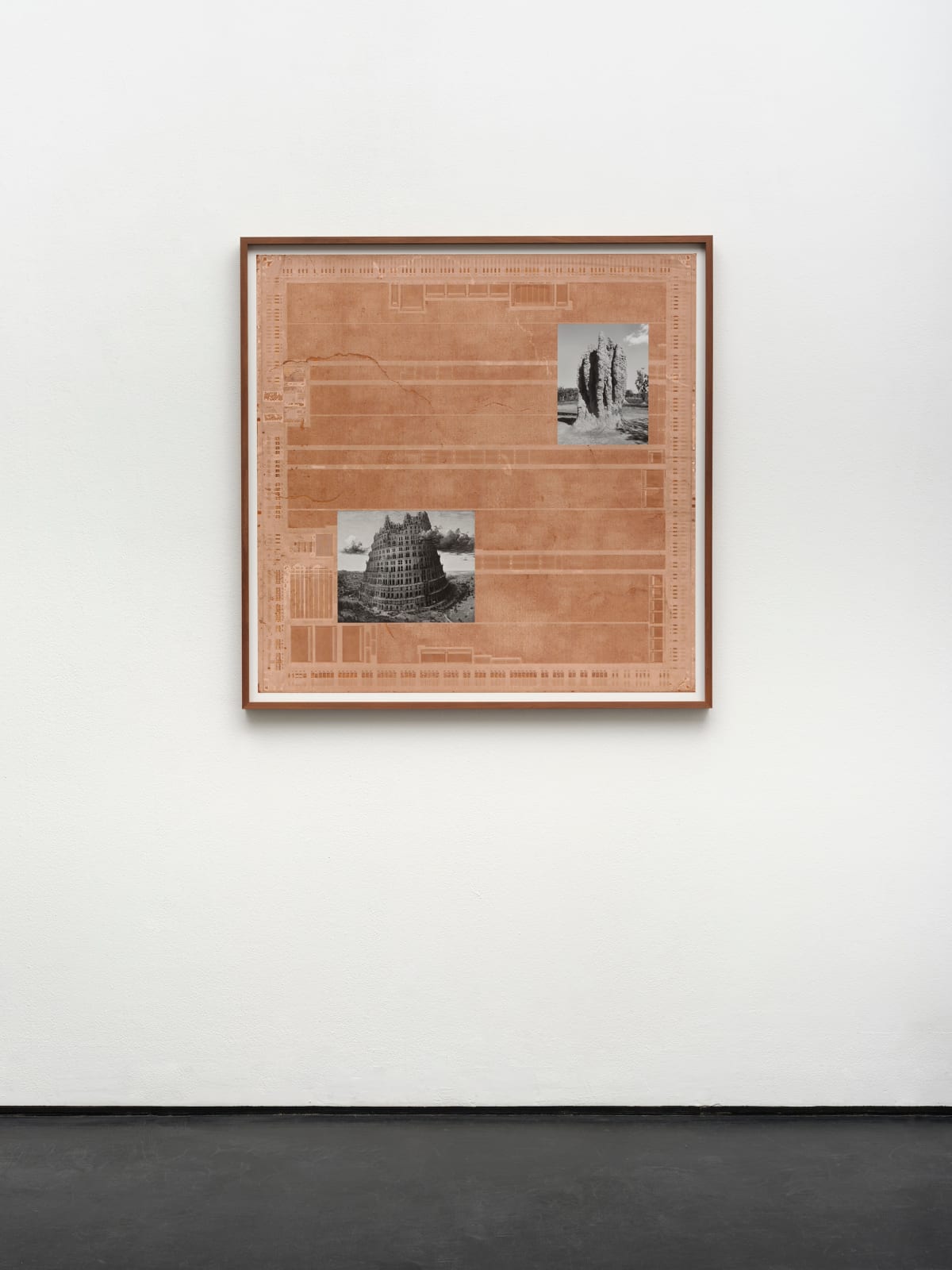Nicolás Lamas
Babel, 2025
Archival pigment print on Hahnemühle paper
102 x 102 x 4 cm
40 1/8 x 40 1/8 x 1 5/8 inches
40 1/8 x 40 1/8 x 1 5/8 inches
Ed. 1/1 + 1 AP
Copyright The Artist
Photo: Marjorie Brunet Plaza
Weitere Abbildungen
In der Wandarbeit „Babel“ (2025) verbindet Nicolas Lamas historische Fotografien mit Abbildern von technischen Schaltkreisen und thematisiert damit die Entwicklung menschlicher Zivilisation. In seinen Werken findet ein ständiger Dialog zwischen...
In der Wandarbeit „Babel“ (2025) verbindet Nicolas Lamas historische Fotografien mit Abbildern von technischen Schaltkreisen und thematisiert damit die Entwicklung menschlicher Zivilisation. In seinen Werken findet ein ständiger Dialog zwischen gegensätzlichen Kräften statt, die ein hybrides Werk hervorbringen, das nicht in eine einzige Richtung definiert oder ausgerichtet werden kann. Lamas versucht in seinen Werken starre Konzepte linearen Fortschritts aufzubrechen und bringt Kunst, Wissenschaft, Technologie und Alltagskultur zusammen, indem er aus einem Fundus an gesammelten Bildern und Gegenständen schöpft. So bilden die collagierten Werke eine neue Sichtweise auf ihre ursprünglichen Kontexte und bieten die Möglichkeit immer neue Schlüsse aus dem Vergangenen zu ziehen, was die Grundlage für die Vorstellung einer möglichen Zukunft bildet.
Der Titel „Babel“ verweist auf den mythischen Turmbau als Sinnbild menschlichen Strebens nach Ordnung, Fortschritt und universeller Kommunikation – und zugleich auf das Scheitern dieser Ambitionen. Die Collage aus archivarischen Fotografien und schematischem Plan thematisiert den Versuch, disparate Wissensfragmente zu einem kohärenten Ganzen zu fügen. Doch wie im Turmbau zu Babel gerät auch hier die Konstruktion ins Wanken – Verständigung wird zur Überlagerung, Architektur zur Metapher eines instabilen Wissenssystems.
In the wall piece “Babel” (2025), Nicolas Lamas combines historical photographs with images of technical circuits, thereby addressing the development of human civilization. His works feature a constant dialogue between opposing forces, resulting in a hybrid creation that cannot be defined or oriented in a single direction. Lamas seeks to break down rigid concepts of linear progress in his works and brings together art, science, technology, and everyday culture by drawing from a pool of collected images and objects. In this way, the collaged works offer a new perspective on their original contexts and provide the opportunity to draw ever-new conclusions from the past—forming the basis for envisioning a possible future.
The title “Babel” refers to the mythical Tower of Babel as a symbol of humanity’s striving for order, progress, and universal communication—and at the same time, to the failure of these ambitions. The collage of archival photographs and schematic plans addresses the attempt to piece together disparate fragments of knowledge into a coherent whole. Yet, just like the Tower of Babel, the construction begins to falter—communication becomes superimposition, and architecture becomes a metaphor for an unstable system of knowledge.
Der Titel „Babel“ verweist auf den mythischen Turmbau als Sinnbild menschlichen Strebens nach Ordnung, Fortschritt und universeller Kommunikation – und zugleich auf das Scheitern dieser Ambitionen. Die Collage aus archivarischen Fotografien und schematischem Plan thematisiert den Versuch, disparate Wissensfragmente zu einem kohärenten Ganzen zu fügen. Doch wie im Turmbau zu Babel gerät auch hier die Konstruktion ins Wanken – Verständigung wird zur Überlagerung, Architektur zur Metapher eines instabilen Wissenssystems.
In the wall piece “Babel” (2025), Nicolas Lamas combines historical photographs with images of technical circuits, thereby addressing the development of human civilization. His works feature a constant dialogue between opposing forces, resulting in a hybrid creation that cannot be defined or oriented in a single direction. Lamas seeks to break down rigid concepts of linear progress in his works and brings together art, science, technology, and everyday culture by drawing from a pool of collected images and objects. In this way, the collaged works offer a new perspective on their original contexts and provide the opportunity to draw ever-new conclusions from the past—forming the basis for envisioning a possible future.
The title “Babel” refers to the mythical Tower of Babel as a symbol of humanity’s striving for order, progress, and universal communication—and at the same time, to the failure of these ambitions. The collage of archival photographs and schematic plans addresses the attempt to piece together disparate fragments of knowledge into a coherent whole. Yet, just like the Tower of Babel, the construction begins to falter—communication becomes superimposition, and architecture becomes a metaphor for an unstable system of knowledge.









